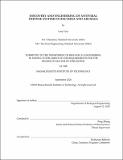Discovery and engineering of antiviral defense systems in bacteria and archaea
Author(s)
Gao, Linyi,Ph. D.Massachusetts Institute of Technology.
Download1249551561-MIT.pdf (83.02Mb)
Other Contributors
Massachusetts Institute of Technology. Department of Biological Engineering.
Advisor
Feng Zhang.
Terms of use
Metadata
Show full item recordAbstract
Viruses are the most abundant and diverse life form on Earth. With over 10³¹ viral particles in existence, viruses fundamentally shape global biogeochemistry and ecology. Most viruses infect bacteria, archaea, and other microbes, and the threat of infection continually challenges microbes' survival. As a consequence of this expansive war, bacteria and archaea have acquired a potent arsenal of molecular defense systems in order to survive. Known defense systems, such as CRISPR, have given rise to transformative technologies including genome editing. However, defense systems as a whole remain underexplored. Continued investigation of these systems and the warfare between microbes and viruses may lead not only to a better understanding of basic microbiology and evolution, but also to new technologies and therapeutic applications. In this thesis, we investigate the collective arsenal of molecular defense systems that bacteria and archaea use to fight viral infections. First, we focus on known defense systems and use protein engineering to increase the specificity and targeting range of CRISPR enzymes for human genome editing. Second, by computational mining and experimental reconstitution, we discover 29 novel defense gene cassettes that are collectively present in one third of all sequenced bacterial and archaeal genomes. These systems incorporate enzymatic activities not previously implicated in antiviral defense, including RNA editing and retron satellite DNA synthesis. In addition, we predict a diverse set of other putative defense genes that remain to be characterized. These results highlight an immense array of molecular functions that bacteria and archaea employ against viruses.
Description
Thesis: Ph. D., Massachusetts Institute of Technology, Department of Biological Engineering, September, 2020 Cataloged from the official PDF version of thesis. Includes bibliographical references.
Date issued
2020Department
Massachusetts Institute of Technology. Department of Biological EngineeringPublisher
Massachusetts Institute of Technology
Keywords
Biological Engineering.